A. J. Stevens & Company
Limited (1909)
| The brothers founded a new company
called A. J. Stevens & Company Limited on 14th November
1909. The Directors were George, Harry, Jack, and Joe
junior. They started with a private share capital of £1,000.
All of the shares were held by the 4 directors. |
|
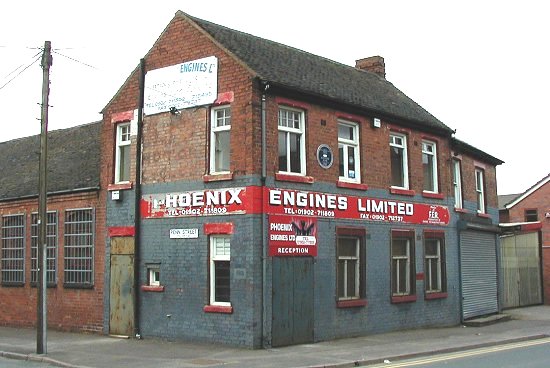
Retreat Street Works in 2001. |
The brothers acquired freehold premises in Retreat
Street, on the opposite side of the street to the Stevens Screw
Company's works.
The company was
set-up so that the
brothers could design and manufacture motorcycles, after the
unfortunate loss of Wearwell. |
|
They decided to produce motorcycles
under the A.J.S. name, which came from Jack Stevens'
initials. Jack's initials were chosen as he was the only one
of the brothers to have two Christian names; Albert and
John.
|
|
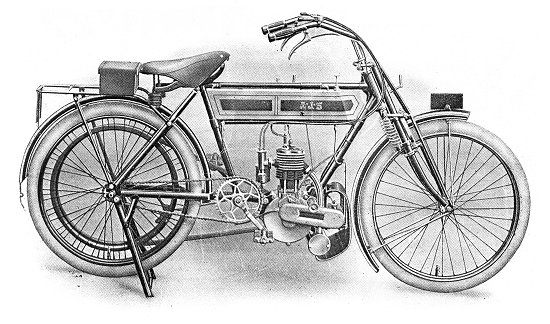
The model 'A' from the 1910 catalogue. |
Harry soon set about designing the
first two machines, called the model 'A' and the model 'B'.
Model 'A' was the cheaper machine,
fitted with a 2½hp. single cylinder, side valve engine and a
direct belt drive.
It sold for 37 guineas.
|
| The model 'B' used the same engine but was fitted with a
2 speed gearbox, cork inserted clutch, and a chain drive.
It sold for 44 guineas.
The first machines were completed in August 1910.
Production costs were largely paid by Harry, from the money
he got for designing Sunbeam's first motorcycle. |
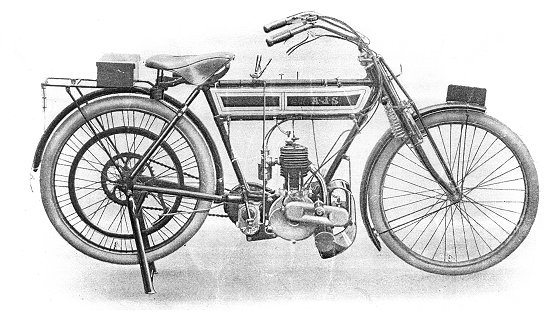
The model 'B' from the 1910 catalogue. |
| Initially frame and engine production
was carried out at the Pelham Street works, with final
assembly at Retreat Street. In late autumn the whole
business moved to Retreat Street, when Clyno came to
Wolverhampton and took over the Pelham Street works.
The new
machines were exhibited at the 1910 Cycle Show at Olympia in
London, along with a one-off 3½hp. V-twin, chain-drive
machine. The show was a great success and a lot of orders
followed. H. Taylor & Company was appointed as the sole
London A.J.S. agent, and fame followed as the machines were
very successful in trials events.
In 1911 two specially prepared A.J.S.
motorcycles were entered for the Isle of Man T.T. They were
ridden by Jack Stevens and J. D. Corke, and finished in 15th
and 14th place respectively. |
|
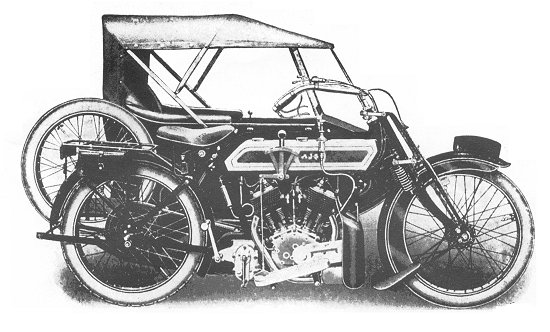
A model 'D' with sidecar. From the
1914 catalogue. |
The company’s products were displayed at the 1911
Olympia Show, including the new model ‘D’ which was launched
in 1912. It had a 5hp. V-twin engine with a 2 speed
gearbox, chain drive, kick start and sold for 60 guineas.
|
|
In 1912 sales again greatly
increased, and the future looked very bright.
In 1913 the model
'A' was discontinued and the model 'B' updated. The
alterations included a 2 or 3 speed gearbox and enclosed
chain drive. The model 'D' was given a 6hp. V-twin engine,
and a sidecar version was introduced.
The A.J.S. sidecar was
made by C. W. Hayward, based in Church Street. The 2 speed
model ‘B’ sold for 46 guineas, the 3 speed version sold for
51 guineas, and the model ‘D’ sold for 69 guineas.
The company decided to enter two
machines in the 1913 Isle of Man Junior T.T. They were
ridden by Billy Heaton and Cyril Williams. Billy Heaton
finished in 9th place after being delayed by several
punctures. Cyril Williams was less successful because of
mechanical problems. He failed to finish.
Sales continued to increase, and it
became difficult to keep up with demand. The model ‘D’ was
extremely popular, and the model ‘B’ sold very well.
Castings for the engine cylinders etc.
were produced in the foundry of Joseph Evans & Sons at
Culwell Works, where Jack had been an apprentice.
|

From 'Motor Cycling', August 1914. |
|

An A.J.S. 6hp. 3-speed motor carrier
from 1914. |
1914 saw the introduction of the 6hp. 3-speed motor
carrier using a model 'D' machine. It was developed as a
goods delivery vehicle, capable of carrying heavy loads up
any hill.
By changing the carrier for a sidecar it could also be
used as a pleasure vehicle. |
Little thought was given to the 1914
T.T. until the last minute, because of production
difficulties at the works, and also plans to float a new
company. A new 2¾hp. sports machine was quickly developed
for the race, and it proved to be a great success. Five
A.J.S. machines entered the event. They were ridden by Eric
Williams, Cyril Williams,
W. Jones, Bert Haddock, and Billy Heaton. |
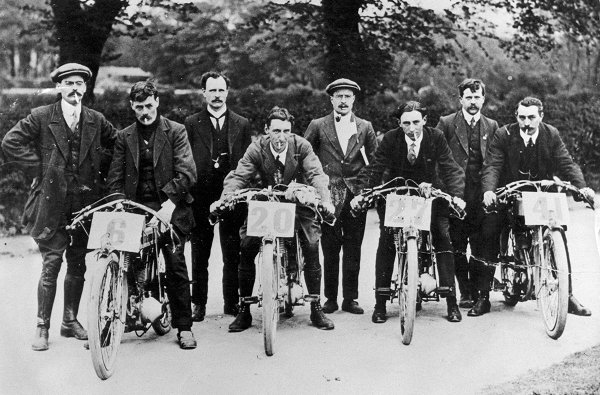
The Stevens brothers and four of the
riders in the 1914 Junior Isle of Man T.T. Left to right:
Jack Stevens, Billy Heaton, Harry Stevens,
Cyril Williams, George Stevens, Eric Williams,
Joe Stevens junior, and Bert Haddock. |
The race was a great success for the company.
Eric Williams finished in first place at a record average
speed of 45.58m.p.h. The results for the A.J.S. team were as
follows:
| Eric
Williams |
1st place |
| Cyril
Williams |
2nd place |
| W. Jones |
4th place |
| Bert
Haddock |
6th place |
| Billy
Heaton |
29th place |
|
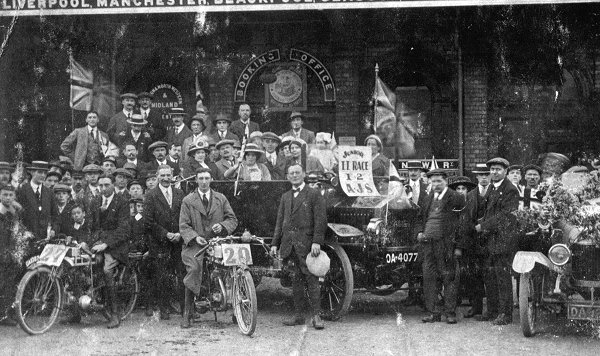
The A.J.S. team's triumphant return to
Wolverhampton. The two riders are Eric Williams on the left,
and Cyril Williams on the right. The Stevens family are sat
in the charabanc in the centre. |
|
On their return to Wolverhampton the
team was given a warm welcome by a large crowd at the High
Level Station. Members of the press were also present. The
party left in a procession to the works in Retreat Street
where they were greeted by another large crowd. Later,
everyone attended a reception at Kings Hall Restaurant, the
headquarters of the Wolverhampton Motor Cycle Club.
A month later Cyril Williams won the Brooklands T.T. on the same machine that he rode on the Isle
of Man.
Sales continued to soar, the sidecar
version of the model 'D' proved so popular that the company
could not keep up with demand, and many delays led to a
lot of impatient customers. Orders also poured in for the
2¾hp. sports machine following its success at the T.T.
It
was essential to increase production, but in order to
achieve this, additional finance would be required, and so a
new public company was formed. The new company, called A. J.
Stevens & Company (1914) Limited, with a nominal share
capital of £50,000 was founded on 18th July,
1914. The directors were George Stevens, Harry Stevens, Jack
Stevens, Joe Stevens junior, E. E. Lamb (stockbroker), and
E. L. Morcom (engineer). The registered office was in
Retreat Street.
|
 |
 |
 |
| Return to
the previous page |
Return to
the beginning |
Proceed to Sidecars |
|